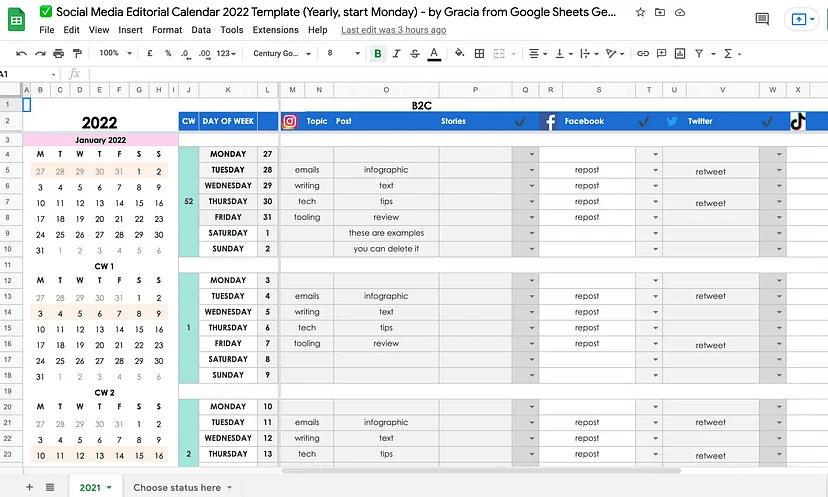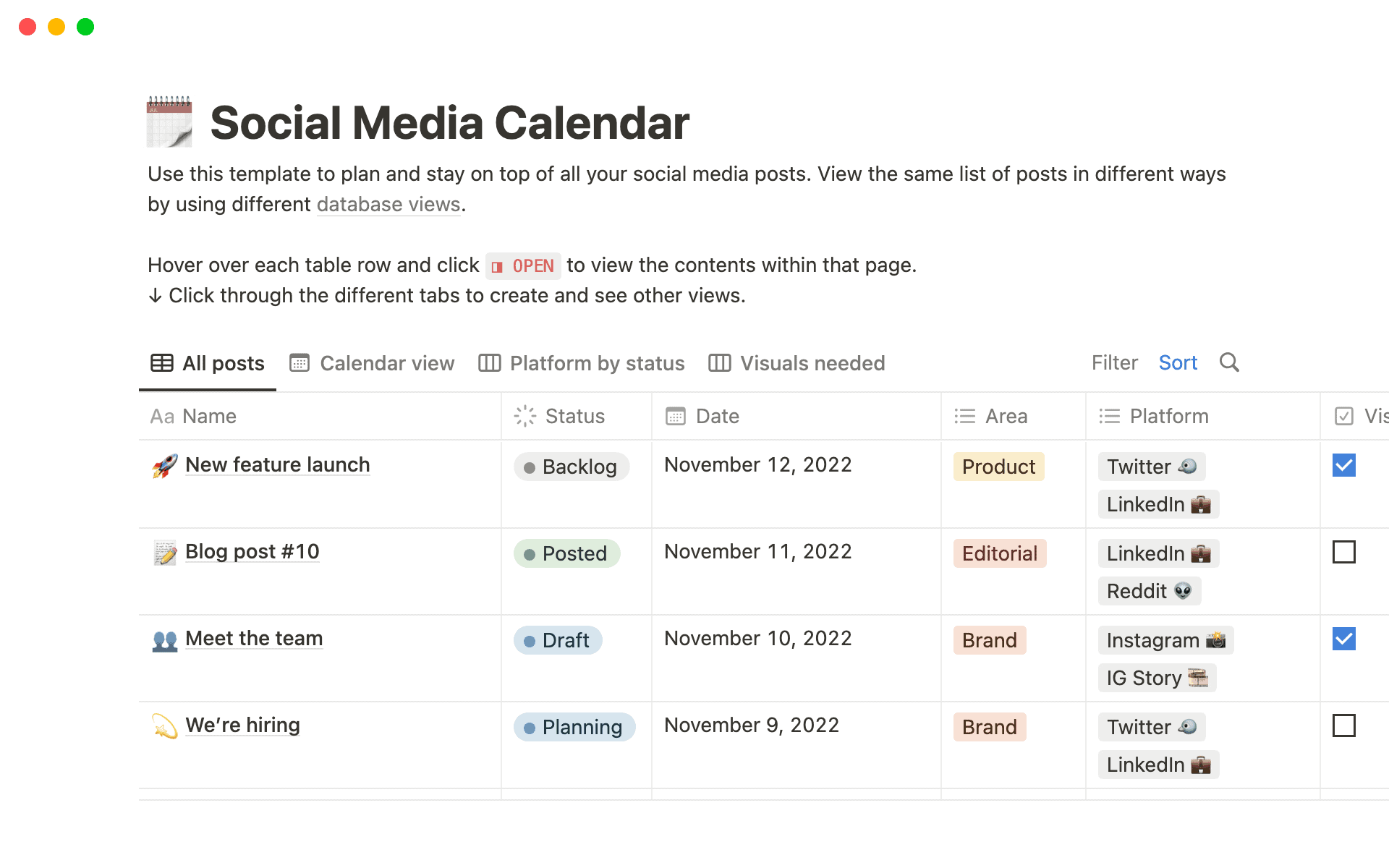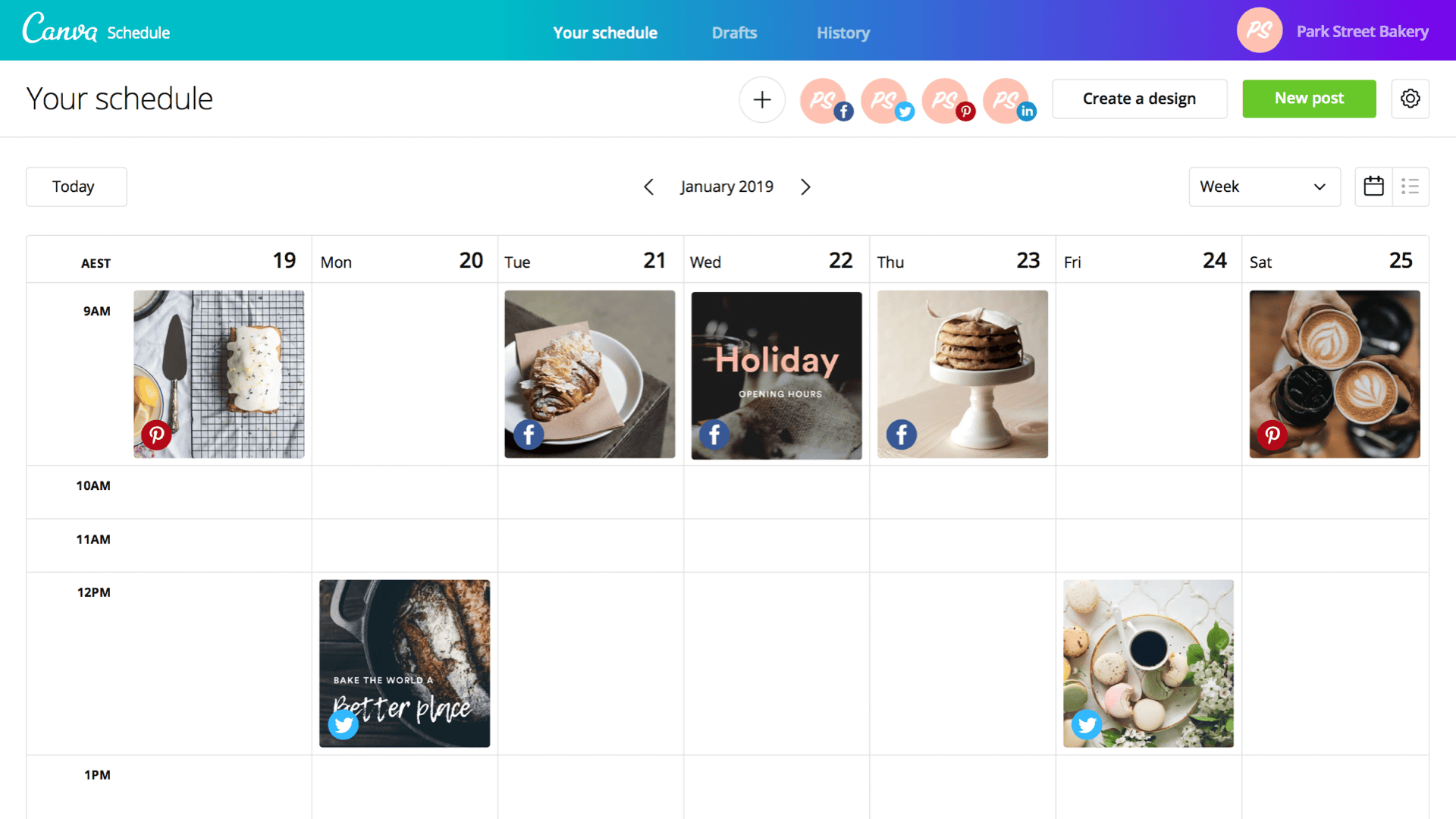A social media calendar is a highly important tool for all marketers.
Posting right after you come up with an idea is not a good idea. There is a high chance you can make mistakes and typos.
This is where social media calendars come in handy. They allow marketers to easily create, edit, collaborate on, and schedule posts.
In this blog, you will learn how to build an effective calendar to maximize your social media marketing efforts and keep your audience engaged with compelling and consistent content.
Let’s start!
What is a Social Media Calendar?
A social media content calendar is a spreadsheet or app used by marketers for planning, organizing, and tracking social media posts.
It enables marketers to organize their social media postings for the upcoming weeks and months. Additionally, it helps you coordinate content so you don’t forget about important events or deadlines.
A good social media calendar contains the following information about each scheduled post:
- When you plan to publish
- Which social media channel and account will you share your content on
- Social media post format (reel, story, in-feed post, etc.)
- Content materials (e.g., copy, photos, infographics, or video)
- Which hashtags and links are you going to use.
Why to Create a Social Media Calendar?
There are several benefits of having a social media calendar.
Below are a few:
Saves time
A social media calendar can free up a lot of time and allow you to stay organized, especially when managing several social media accounts. Whether you have launched a WhatsApp marketing or any other marketing campaign, a well-planned social media calendar ensures that your content is consistently delivered to your audience. Planning out content for a few weeks or months in advance saves you from struggling to find trending events or ideas.
Maintains consistency
Of course, there’s no strict rule of how often you should post, but it’s essential to post frequently to keep an active online presence. Having a proper social media content calendar allows teams to prioritize quality, not quantity. Plus, planning is great in terms of consistency in your brand voice and style across different channels. In other words, you will pay more attention to what you post, keeping your brand identity in mind.
Streamlines collaboration
A well-crafted social media calendar improves visibility across teams, as it provides a large picture of what content is coming for the coming weeks/months. A content calendar also enhances communication and collaboration between team members because everyone can look at the calendar and know what to expect. It also ensures that your social media efforts align with your overall marketing strategies.
For instance, stakeholders in the marketing campaign can easily view what you have prepared and give feedback if needed.
How to Create a Social Media Calendar: An 8-Step Guide
Conduct a Social Media Audit
Before building your social media content calendar, you need to run a social media audit of formerly created content to assess your current online presence.
When doing a social media audit, pay attention to
- Important metrics and KPIs for each account by platform
- Your company’s goals for each social media account
- Your target audience
- Highest and lowest-performing posts and social media campaigns
- Opportunities for improvement or experimenting
- Posting frequency
- Gather native analytics by using Instagram Analytics or Facebook Insights. You can also use external social media analytics tools for more comprehensive analysis.
In addition to this, you can also conduct a competitive analysis during your social media audit. Auditing competitors in your niche can help you identify gaps in your own social media strategy.
Conducting an audit will allow you to identify how to curate posts for your social media calendar template and what content you should post for your audience. The purpose is to give you a strategy to fill every day of your content calendar. When you know what’s going well, you have a chance to be better positioned to meet your company’s goals.
Choose Your Social Media Channels
Once you’ve successfully finished your audit, it’s high time to use what you have learned. Your audit should allow you to have a deep understanding of what you’re doing well, where you should experiment, and which platforms are best for your audience.

For instance, let’s assume you have been using Facebook as your main social media channel for engagement, but you’ve noticed a significant drop in the last few weeks. Your audit can show you what engagement on FB looks like for your competitors, plus what is working for your business and what should be improved.
Regardless of which social media platform you choose, using a trustworthy VPN for secure online activities is a must. VPNs encrypt your internet connection, protecting your data and privacy while using social media. This added layer of security ensures that your online interactions, whether for business or personal use, remain private and protected.
Plan Your Content for Each Channel
Once you’ve decided what platforms to use for your social media campaigns, it’s time to plan your social media content. Utilize SEO Tools Centre’s AI sentence rewriter to craft unique social media content tailored for various channels.
First, you should review your team and budget. This will allow you to understand the amount of high-quality content you can produce.
Keep your brand guide in mind and use the results of your social audit analysis to create content that resonates with your target audience.
Aim for creating a variety of content. Indeed, videos are great, but other content formats like images, infographics, and live streams are effective too. Use mixed to keep your audiences’ feeds fresh and engaging. It’s also an amazing way to keep up with social media trends and make sure your content is relevant. If you want to take your content to the next level, don’t forget to hire UI/UX designers who can enhance the visual appeal and user experience of your digital assets.
When crafting content, keep the 80-20 rule in mind. Eighty percent of your posts inform, educate, or entertain, whereas twenty percent of your social media posts should promote your business or drive sales. This way, you can ensure you keep the right balance of creating educational and promotional content.
Decide What to Include in Your Social Media Calendar
Depending on the size and nature of your business, your social media calendar may vary. For instance, a small business is more likely to have a much simpler calendar than a large organization with a dedicated social team.
The next step is to decide what information your social media calendar should include. Make a list of information and functions that matter to you.
Start with simple details, like social media platform, date and time (and time zone), visuals, copy, link to assets, published post links, and UTM parameters. Additionally, you can include details like what content format you are going to use (feed post, Reel, Story, poll, ad, live stream, shoppable post, etc.), geo-targeting, whether it is a paid or organic post, and its approval status.
If you’re just getting started, using a simple spreadsheet is fine. If you’re looking for a more sophisticated solution, consider using social media management tools. They help you craft your posts, schedule them beforehand, recommend the best times to post for each channel, enable you to bulk schedule your content, and more. This way, you can streamline your social media calendar efforts and make the most of it.
Choose the Best Days and Times to Post
Once you decide what types of content to post, you can create a posting schedule to maintain an active online presence and be aware of the ideal times for publishing.
Analyzing the results from your audit and competitive analysis can help you determine the best times for posting. Take a look at the publish dates and times for each social media platform and make a note of any specific patterns. This information will help you plan your posts more effectively and gain more visibility.
There are some best practices around when to post on each social media platform.
Based on the analysis of 35 million posts, below you can find the best times to post.
- Instagram: 9 a.m., 8 a.m., and 10 a.m. on Wednesday, Friday, and Tuesday
- Facebook: 9 a.m., 7 a.m., and 10 a.m. on Friday, Wednesday, and Monday
- Twitter: 10 a.m., 9 a.m., and 12 p.m. on Wednesday, Friday, and Thursday
- LinkedIn: 11 a.m., 10 a.m., and 12 p.m. on Tuesday, Thursday, and Wednesday
- Pinterest: 9 p.m., 4 p.m., and 8 p.m. on Friday, Tuesday, and Thursday
Use a Social Media Calendar Template
Using a social media content calendar template can help you stay organized, improve workflows, enhance collaboration, and track important metrics. Your social media calendar template should include the following:
You already know what to include in your social media calendar.
You can use a digital calendar or a simple Google spreadsheet for your template or use tools like Hootsuite’s social media calendar. Similar to the best family calendar apps, your social media calendar app should also be user-friendly and intuitive. It is totally up to you. If you are just starting out, it is better to use a simple spreadsheet, and later, when you get comfortable with crafting social media calendars, you can use more powerful tools.
Collaborate With the Team
A social calendar should make sense to your team members. It is crucial to be on the same page with your team and ask for feedback and ideas from them and stakeholders to ensure your social media calendar meets everyone’s needs.
As you start to work with your calendar, analyze whether it works for both you and your team, and ask the team to provide their honest opinions. For example, if it feels tiring and complicated, maybe you want to dial back to refine some aspects of your calendar. Or, maybe it’s not detailed enough. In that case, you may need to add more information.
Your calendar will keep evolving as your business does — and that’s totally fine! All you need is to regularly check and update your calendar to make sure it is relevant for all parties involved.
Assess and Improve Your Social Media Calendar
Your social media calendar isn’t merely a planning tool. It’s also an amazing method to track and measure metrics across every channel you use. By analyzing the information you collect from your social media campaigns, you can optimize your social media calendar.
More specifically, you can identify content that might need to be improved or repurposed. Also, when content performs well, you can make a note so that you can remember to use it again in the future for other social media campaigns.
Remember that different social media platforms serve different purposes, so you should make a strategic plan when trying to boost your reach and engagement on other platforms. Just because a particular post went viral on one platform, it doesn’t mean it will perform well on others.
So, keep assessing and improving your calendar. Don’t assume it is a one-time task. It is an ongoing task that you should take seriously if you want to nail your social media campaigns.
Best Social Media Calendar Apps and Tools
Google Sheets
Google Sheets are quite easy to use. There are a bunch of social media calendar templates you can use from Google Sheets. It is convenient when it comes to viewing upcoming posts and adding comments for feedback and other collaboration.

Follow these steps to create a calendar using Google Sheets
- Open Google Sheets
- Create a New Sheet by clicking on “Blank”
- Set Up Columns and label them for “Date,” “Social Media Platform,” “Content,” “Caption,” “Hashtags,” “Image/Link,” and “Status.
- Add Dates for your social media posts.
- Fill in Details
- Use the “Status” column to keep track of the progress of each post (e.g., “Scheduled,” “Not posted,” “Posted”).
- Use formatting, such as color-coding for different channels, to make it easy-to-read.
Once you finished creating your calendar, share it with your team members and update it when needed.
Notion
Notion is not only a great note-taking app but also a powerful tool for marketers. The app has a database feature that allows to create different templates, including social media calendars.

Follow these steps to create a social media calendar using Notion:
- Log in to Notion and access your workspace.
- Click “Add a Page” to create a new page where you’ll create your social media calendar.
- Create sections for each month or week, depending on what planning interval you prefer.
- Add a table to organize your calendar within each section. Click “+ Add a block” > “Table.
- Create and label columns for “Date,” “Platform,” “Content,” “Caption,” “Hashtags,” “Image/Link,” and “Status.”
- Fill in each row with the respective content details for your social media posts.
- Apply formatting to make your calendar visually compelling and easy to read.
Once you are done with creating your calendar, make sure to share it with your team and update it when needed.
Canva
Canva is a free online design tool that allows you to create compelling visuals for your social media channels.

To create a social media calendar in Canva, follow these steps;
- Log in to your Canva account or create an account if you don’t have one.
- Click “Create a design” and choose “Custom dimensions.” Enter the dimensions for your social media calendar (for instance, 1080×1920 pixels for Instagram).
- Browse Canva’s templates and pick a blank template or one that best suits your style.
- Click “Elements” and search for a calendar template. Once you find a suitable template, drag and drop it onto your design.
- Change the calendar’s colors and fonts to match your brand identity.
- Add the months and dates to the calendar cells.
- Create columns for “Platform,” “Content,” “Caption,” “Hashtags,” and “Status.”
- Add your content details in the respective columns for each date.
- You can also upload images to represent your posts and add them to the design if needed.
Once you are done with building your social media calendar, you can save and download it. Or, you can print it out and distribute it to your team members to make sure that everyone is on the same page.
Final Thoughts on How to Create a Social Media Calendar
A social media calendar is a must for companies of all sizes. It helps you stay organized and set up your daily schedule. With a calendar, you can easily do your content planning and schedule your posts beforehand. This allows you to focus on more complex tasks, as well as enjoy your vacations and weekends, as your social media profiles are active even if you’re not online.
So, look forward and think about what lies ahead. It does not mean you should plan for the next few years. It is just about considering what you’re going to do next month. With our guide and social media calendar tools, you can build a calendar on your own.
Thanks for reading, and good luck!

